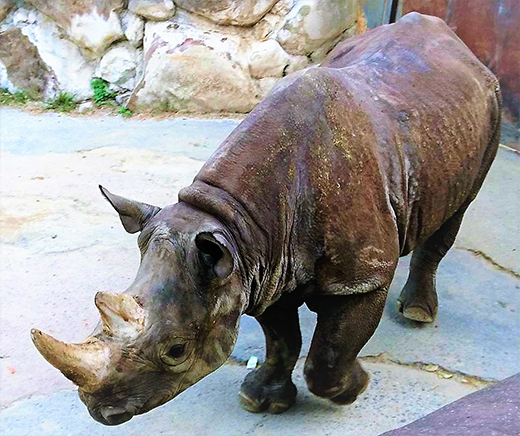 KM-One Special Project【クロサイプロジェクト】
KM-One Special Project【クロサイプロジェクト】
クロサイを追え! ―絶滅危惧種クロサイ―
南アフリカに位置する世界遺産・イシマンガリソ湿地公園に生息するたくさんの動物たち。その中でも密猟などによって年々数が減少傾向にある動物、クロサイに私たちは焦点をあてます。CEOであるアンドリュー氏からの協力要請も受け、クロサイに隠された謎に迫ります。
 KM-One Special Project【クロサイプロジェクト】
KM-One Special Project【クロサイプロジェクト】南アフリカに位置する世界遺産・イシマンガリソ湿地公園に生息するたくさんの動物たち。その中でも密猟などによって年々数が減少傾向にある動物、クロサイに私たちは焦点をあてます。CEOであるアンドリュー氏からの協力要請も受け、クロサイに隠された謎に迫ります。
体長 280-305㎝、体重 350-1300㎏にもなるクロサイ。頭に大きな角が2本あり、枝や葉を食べやすいよう口が尖った形をしていることが特徴です。英語では別名Hook-lipped Rhinocerosと呼ばれ、カギ型の口をしたサイという意味。シロサイとは対照的でまず草を主に食べるシロサイに対してクロサイは葉っぱを多く食べます。また黒い体をしているからクロサイ、白い体をしているからシロサイというわけではないのです。シロサイの口の形状が広いことから‘WIDE RHINOCEROS’と呼ばれていたのを‘WHITE RINOCEREOS’と聞き間違えたことにより、シロサイの呼び名が誕生しました。またシロサイがいるならクロサイもとなったのが一説の由来と言われています。皮膚の色はどちらも泥を体に塗って皮膚を守るので、グレーがかった色をしています。性格はアグレッシブで凶暴と言っても過言ではないでしょう。自分が進もうとする方向に少々の薮があっても、避けずに突進しぶち壊して進んでいく気性の荒い動物です。主にサバンナや森林・藪地などに生息していますが、クロサイは山地の森林などでも発見されることがあります。行動範囲は食糧事情などによって大きく変わり、およそ3k㎡~133k㎡と言われていてかなり広範囲です。草食性でマメ科の低木を中心に木の芽や枝・樹皮・果物などを主食としていますが、トゲのあるアカシアなどもキリンのように食べてしまいます。名前の由来にもなっているようにクロサイのこの食性によって、木の芽や枝などを食べやすいようにとがった形をしていて、かなり自由に動かすことが出来るようになっています。それとは対照的に地面近くの草を食べるシロサイの口は平たくて広いのです。この口先の形の違いから、クロサイとシロサイを見分けることが出来ます。

クロサイは他のサイの仲間と同じように、人間に角をねらわれてきた動物です。サイの角は薬になると信じられていますが、効き目については今のところはっきりとは分かっていません。さらにクロサイの場合は角が短剣の柄の材料としても流行しはじめ、とても高い値段で取引されるようになりました。こうしてクロサイは1995年にはわずか2410頭まで数が減ってしまったのです。またクロサイは少なく産んで大切に育てる動物です。一夫一妻制で一回の出産で一人の子を産みます。野生のクロサイには天敵が少なく、多くの子どもが無事に大人へと成長できます。しかし人間という天敵が現れたことで、死んでいく数が生まれる数を大きく上回ってしまいました。現在は保護活動でクロサイは増えていますが、密猟を厳しく取り締まらないとすぐにまた数が減ってしまうでしょう。

In pursuit of Black Rhinoceros, Diceros bicornis Linnaeus 1758
World Heritage iShmangaliso Wetland Park locates north-eastern part of South Africa. The park ranges 332,000 hectare and contains three major lake systems, several interlinking ecosystems, swamp forests, estuarine system, and vegetated coastal dunes. The wide park is including variety of fauna and flora and the endangered black rhinoceros is regarded as one of representative of the park. We are required from the CEO of the park to record black rhino and will try to observe and film the way of lives of the animal in detail.
What’s rhinoceros?
Rhinoceros refers Greek meaning rhino-nose and ceros-horn. They are basically herbivorous. The family Rhinocerotidae consists of five species; three Asian species, Javan rhino Rhinoceros sondaicus, Sumatran rhino Dicerorhinus sumatraensis, and Indian Rhinoceros unicornis, and two African species, white rhino Ceratotherium simum Burchell 1817 and black rhino Diceros bicornis Linnaeus 1758. Both the last two species are found in the South Africa and biologically, as it can be expected, they are closely related than to other Asian three species. The scientific name for black rhino is Diceros bicornis, and generic name “Diceros” (Greek) means two horns and also specific name “bicornis” (Latin) means two horns, thus both generic and specific names refer same morphological feature in different languages. While that for white rhino is Ceratotherium simum, and generic name “Ceratotherium” refers “cerato” (Greek) meaning horn and “ther” (Greek) meaning wild animal and specific name “simum” (Greek) means flat nosed. Common English name for the two African rhino need some explanation. Both “black” and “white” prefixes do not reflect their body color, but their real body color is ashy grey. By the 1830’s both white and black rhinos were referred for the two species. Usually it is said that ‘white’ originated from Ductch word ‘wijde’ for ‘wide’ showing it’s wide flat nose but the first expression for the “white” rhino appeared in 1801 by a hunter, John Barrow, 16 years before the original description of the white rhinoceros by Burchell in 1817. Thus the general recognition of the origin of the word “white rhinoceros” does not make sense (Darren Naish, 2009). Also the origin of “black rhino” is quite uncertain. Nowadays, names of these two African rhinoceros are not suitable for their nature, the following two specific names have been used, the square-lipped (for the white) or hook-lipped (for the black) rhinoceros (Animal Corner).
What’s black rhinoceros?
Unlike the scientific name of black rhinoceros, Diceros bicornis referring it’s two horn on the snout, this feature is quite fitted for other extant species of rhinoceros excepting single horned Indian rhinoceros. Occasionally, black rhinoceros has third small horn. The most striking difference between the two South African rhinoceros is the shape of mouth. Black rhinoceros (hooked-lipped rhino) has pointed mouth with prehensile lip suitable for picking leaves of trees whereas white rhinoceros (square-lipped rhino) has flat broad mouth suitable for grazing. Sizes of the body of these two species also differ, black rhinoceros weighs 1600kg, and stands 1.7m high at the shoulder and length is 3.8m, females are smaller than males, whereas white rhinoceros weighs around 2400kg, height is about 2m, length is about 4m, and females are smaller than males. Thus black rhinoceros is fairly smaller than white rhinoceros. Habitat of the two black rhinoceros covers frombushy plains to rugged hills. Black rhinos are shy and solitary animal but in some occasion, they act in aggressive ways. This aggressive behavior is simply because of their poor eyesight and when they smell or hear something unfamiliar, they will react for defense in their way and in mistaken case they attack trees and even rocks. Diet of black rhinoceros covers a broad variety of plants, leafy plants, branches, shoots, thorny wood bushes and fruit.
Why are they endangered?
Most species of rhinoceros are endangered because of several reasons. Rising demand from Asian countries for rhino horn of commercial purposes results poaching of the animals. Horns of Rhinoceros are composed mostly the protein keratin, that is the chief component of hair and finger nails. The most similar structure is found in horses’ hooves, turtle beaks, and cockatoo-bills (Nature) Thus, the use of rhinoceros horns lacks any pharmacological base excepting the placebo effect. Demand for handles of dagger, some Muslim men use the rhinoceros horn. In China, the horn is used as ornamental things from early centuries (Nature). Among the five extant species, the black rhino is critically endangered. Between 1970 and 1992, more than 90% of remaining black rhinos were sacrificed. Poaching prevailed through Kenya, Tanzania and most of south-eastern Africa. Political instability, wars, and poverty are accelerating poaching and illegal trade of the rhino horns. Also, habitat loss by aridification of the land and by human activity threatens the Rhinoceros. Black rhino requires quite wide range of land for their diet, an individual occupied 0.14km2 (J.Mukinya 1973). We would like to announce the magnificence of the park and to promote the importance of conservation of wilderness to maintain biological diversity for our future!